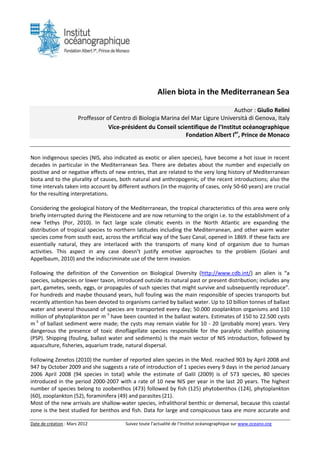
Alien biota in the mediterranean sea
- 1. Alien biota in the Mediterranean Sea Author : Giulio Relini Proffessor of Centro di Biologia Marina del Mar Ligure Università di Genova, Italy Vice-président du Conseil scientifique de l’Institut océanographique Fondation Albert Ier, Prince de Monaco Non indigenous species (NIS, also indicated as exotic or alien species), have become a hot issue in recent decades in particular in the Mediterranean Sea. There are debates about the number and especially on positive and or negative effects of new entries, that are related to the very long history of Mediterranean biota and to the plurality of causes, both natural and anthropogenic, of the recent introductions; also the time intervals taken into account by different authors (in the majority of cases, only 50-60 years) are crucial for the resulting interpretations. Considering the geological history of the Mediterranean, the tropical characteristics of this area were only briefly interrupted during the Pleistocene and are now returning to the origin i.e. to the establishment of a new Tethys (Por, 2010). In fact large scale climatic events in the North Atlantic are expanding the distribution of tropical species to northern latitudes including the Mediterranean, and other warm water species come from south east, across the artificial way of the Suez Canal, opened in 1869. If these facts are essentially natural, they are interlaced with the transports of many kind of organism due to human activities. This aspect in any case doesn’t justify emotive approaches to the problem (Golani and Appelbaum, 2010) and the indiscriminate use of the term invasion. Following the definition of the Convention on Biological Diversity (http://www.cdb.int/) an alien is “a species, subspecies or lower taxon, introduced outside its natural past or present distribution; includes any part, gametes, seeds, eggs, or propagules of such species that might survive and subsequently reproduce”. For hundreds and maybe thousand years, hull fouling was the main responsible of species transports but recently attention has been devoted to organisms carried by ballast water. Up to 10 billion tonnes of ballast water and several thousand of species are transported every day; 50.000 zooplankton organisms and 110 million of phytoplankton per m-3 have been counted in the ballast waters. Estimates of 150 to 22.500 cysts m-3 of ballast sediment were made; the cysts may remain viable for 10 - 20 (probably more) years. Very dangerous the presence of toxic dinoflagellate species responsible for the paralytic shellfish poisoning (PSP). Shipping (fouling, ballast water and sediments) is the main vector of NIS introduction, followed by aquaculture, fisheries, aquarium trade, natural dispersal. Following Zenetos (2010) the number of reported alien species in the Med. reached 903 by April 2008 and 947 by October 2009 and she suggests a rate of introduction of 1 species every 9 days in the period January 2006 April 2008 (94 species in total) while the estimate of Galil (2009) is of 573 species, 80 species introduced in the period 2000-2007 with a rate of 10 new NIS per year in the last 20 years. The highest number of species belong to zoobenthos (473) followed by fish (125) phytobenthos (124), phytoplankton (60), zooplankton (52), foraminifera (49) and parasites (21). Most of the new arrivals are shallow-water species, infralithoral benthic or demersal, because this coastal zone is the best studied for benthos and fish. Data for large and conspicuous taxa are more accurate and Date de création : Mars 2012 Suivez toute l’actualité de l’Institut océanographique sur www.oceano.org
- 2. are influenced by frequency of monitoring and taxonomic expertise availability. The most frequently recorded alien phyla are Mollusca (33%), Artropoda (18%), Chordata (17%), Rhodophyta (11%). Data are scarce or entirely absent for many of the small invertebrate phyla and unicellular organisms. The native range of the alien species in the Mediterranean is the Indo-Pacific Ocean (41%), followed by the Indian Ocean (16%), and the Red Sea (12%), while some species have a pantropical or circumtropical distribution (19%). It is clear that the majority of alien species in the Mediterranean are thermophilic and therefore originated in tropical seas and so climate change favours the introduction of Red Sea species in the south eastern Mediterranean and their rapid spreading northwards and westwards. It similarly favours species coming from the tropical African Atlantic coasts to enter the western basin. Following Galil (2009) There are nearly four times as many alien species along the Levantine coast (456 species) as along the western coast of the Mediterranean (111 species). The majority of aliens in the Eastern Mediterranean entered through the Suez Canal and are called Lessepsian. Although some aliens may be responsible for strong ecological impact and in particular for reducing the population of some native species, others as crustaceans and fish have become important fishery resource. The migration of Lessepsian species, seems to play a key role for fisheries particularly in the Levant basin. Lessepsian migrants caught by fishing gears include nowadays 77 fish and 24 invertebrates species, their numbers are increasing from year to year. Main references Galil B. S. (2009) - Taking stock: inventory of alien species in the Mediterranean Sea. Biological Invasions, 11: 359-372. Golani D. and Appelbaum-Golani B. (2010) - Terminology, pag. 8. In: Golani, D., Appelbaum-Golani, B. (Eds.), Fish Invasions of the Mediterranean Sea: Change and Renewal. Pensoft Publishers, Sofia- Moscow, 332 pp. Por F.D. (2010) - The new Tethyan ichthyofauna of the Mediterranean - historical background and prospect, pp. 13-33. In: Golani, D., Appelbaum-Golani, B. (Eds.), Fish Invasions of the Mediterranean Sea: Change and Renewal. Pensoft Publishers, Sofia-Moscow, 332 pp. Zenetos A. (2010) - Trend in aliens species in the Mediterranean. An answer to Galil, 2009 «Taking stock: inventory of alien species in the Mediterranean Sea». Biological Invasions, 12 (9): 3379-3381. Date de création : Mars 2012 Suivez toute l’actualité de l’Institut océanographique sur www.oceano.org
